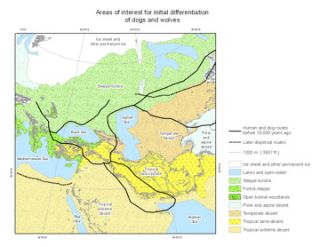X Y Chromosomes
New Study Has Important Implications for Dog Origins
Geneticists link Paleolithic Eurasian hunters and gatherers to First Americans.
Posted November 25, 2013
A study published in the November 20, 2013, online edition of the journal Nature by an international team of geneticists suggests that the first Americans were not solely derived from East Asians but had a mixed genetic heritage that included significant admixture with Upper Paleolithic and Mesolithic hunters and gatherers from Europe. The finding, they say, may explain why some Native Americans appear to have had more European than East Asian cranial features and why they share a haplogroup with Europeans but not East Asians.
This paper focuses solely on people, but as I read it, by revealing a connection between the people of south-central Siberia—the area around Lake Baikal and the Altai Mountains—who ultimately crossed the Bering Land Bridge into the Americas and the hunters and gatherers distributed from North Africa through the Middle East, Central Asia, Europe and western Siberia up to and through the height of the last Ice Age, the study provides a potential explanation for how different types of early dogs could have ended up with the first migrants into the Americas. It also appears to lend support to the theory that dogs have their origins in the admixture of different types of dogwolves, or proto-dogs belonging to these far ranging-people. In short, the dogs were born on the trail of the big game their wolfish forebears hunted.
As I discussed in my last blog posting, a recent proposal by a group of researchers that the dog was born in Europe 19,000 to 32,000 years ago failed to account for why people would have suddenly acquired dogs 13,000 or more years after their arrival in Europe., estimated here at 45,000 years ago. The researchers also failed to show how a fairly diverse group of dogs came to accompany people from the Altai Mountains across the Bering Land Bridge into Americas.
Based on descriptions of Native American dogs and the scant remains of early dogs we have, I postulate that those early types were a generic dog like the Siberian laika [large to medium version]; a large mountain dog type with a short-nosed variant; a medium size dog of the pariah sort, like the current Bedouin dog; and a generic small dog. Cutting across size were black dogs and the genetic freaks that are hairless dogs. Some physiological characteristics like dwarfism could have been captured independently in the New World since they involve rather common mutations. That list of types is tentative and subject to revision; I offer it here as an example.
It is easy to speculate about the regions of origin of these dogs: the Middle East for the pariah/dingo type; the Mammoth Steppe spanning Europe and Siberia for the laika; Eastern Europe for the short-nosed mastiff-type; and the Caucasus for the large mountain dog. The last two could as easily have come from the Pyrenees and southwestern France. I am ignoring Northern Europe as the seat of domestication, although it appears that the people there were companions to a medium to large wolfdog, or wolflike dog, for some time. As I said, those are speculations based on broad types. Pinning them down is complicated by the fact that dogs and people were always on trails that led not only to admixture but also to isolation and inbreeding. I suspect that is one reason the genetic evidence vacillates between a severe genetic bottleneck around the time of transition and a small to minimal bottleneck.
Those are questions for later. For now it is important to establish as a general rule that if a canid found in a given area after about 100,000 years ago appears anomalous, it probably came from somewhere else in the company of one or more humans and other canids who did not die there.
Eske Willerslev of the Centre for GeoGenetics at the University of Copenhagen led the current human study which sequenced the entire genome of a single human juvenile, dubbed MA-1, including the mitochondrial genome and the Y chromosome. MA-1 lived 24,000 years ago in what is now an Upper Paleolithic archaeological site called Mal’ta in south-central Siberia on the Belaya River near Lake Baikal. The researchers believe it is the oldest complete genome sequence of an anatomically modern human.
Excavated between 1928 and 1958, the site also yielded thirty Venus figurines more common, the researchers said to Europe than Siberia.
The full paper is locked behind Nature’s commercial firewall, but a fairly detailed summary is contained here.
Analysis of the mitochondrial genome placed MA-1 in the U haplogroup of anatomically modern humans that occurs from the Middle East and North Africa into Europe, western and central Siberia, as well as through the hub of trade and travel that was the region of the Caucasus and Caspian Sea. They also found considerable admixture—14 to 38 percent with the dispersed East Asians in the vicinity of the Altai Mountains who would become the first Americans.
The researchers also analyzed the Y chromosome and autosomal genome, derived from both parents, and say that the findings place the area Eurasian hunters and gatherers roamed more to the northeast than previously supposed.
Significantly, a partial genome from a person who lived in south-central Siberia after the Last Glacial Maximum shows that the flow of people along those trails continued even after the glaciers had retreated.
Taken together, their findings show a relationship between western Eurasians and Native Americans that is based on gene flow through Upper Paleolithic Siberians who became the first Americans. All other evidence of a mysterious Eurasian presence in the Americas until the Conquest derives from that.
This paper utters not a word about dogs but its implications for understanding dog origins appear large.

This map shows possible areas where dogs emerged.
I am using as illustrations, two maps I had prepared for my book, How the Dog Became the Dog, showing in outline areas I thought were important for early dogs and people. Like many others, I proposed the broad Middle East as the most likely region for the start of differentiation of dogs and wolves because that is where humans and dogs were most likely to have met and where people on the move with their dogwolves were likely to have crossed paths. But the maps also showed people with early dogs moving into all parts of Europe and along the Mammoth Steppe to the Altai Mountains, as it appears now they were. Putting flesh on those bones will be interesting indeed.




